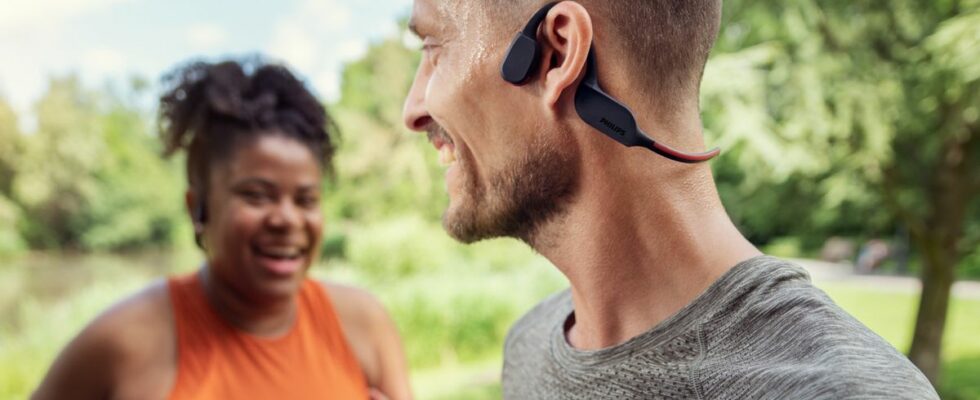Sport, office, telecommuting: bone conduction headphones offer an interesting alternative to traditional headphones or earphones. They leave the ears totally free, able to hear surrounding noises and conversations. Reassuring for doing sports in the city, except for cycling, for which their use is prohibited
, they are also friendly at work and do not cut us off from conversations with colleagues. Without risk for the eardrums, we find more and more of them on the market. While their strengths are numerous, bone conduction headphones still have one weakness: their audio quality. This is where the bone is, alas… Because with these headphones, listening is almost completely devoid of bass. They do not therefore replace classic headphones and earphones, but they are of real interest in specific circumstances, as evidenced by the selection offered by20 minutes
.
The Swimmer: OpenSwim by Shokz Certified IP68 (the highest humidity protection standard), the Titanium helmet open swim
The OpenSwim bone conduction headphones, from Shokz, dedicated to swimming. – Shokz It can withstand complete immersion, up to 2 meters deep, for one hour. Enough to encourage us to cut a few lengths… Moreover, this model is equipped with an MP3 player. This makes it possible to remedy the technical impossibility of Bluetooth to “pass” under water (and to listen to music with your smartphone left at the edge of the pool!). Thus, the memory of this 4 GB headset will allow it to carry up to 1,200 songs. The autonomy of the Openswim is 8 hours.
189 euros. Our opinion :
Who can do more, can do less: perfectly suited to sports and what’s more for swimming (wearing goggles and a swimming cap is not a problem with this helmet), the OpenSwim is not Bluetooth . It can therefore only be used to listen to music stored in its internal memory. Impossible, therefore, to communicate with a smartphone, to take a call, etc.
The worker: X-Vibes, from Crosscall The French manufacturer of resistant smartphones and tablets Crosscall is developing its product line with its,X Vibes

Crosscall’s X-Vibes Bone Conduction Headset is preferred for professional use. – Cyril Perronace/Crosscall Titanium headband covered on the inside with an antiperspirant grip, battery life of up to 14 hours, remote microphone with ambient noise reduction for optimized conversations: the X-Vibes, which benefits from IP67 certification, is versatile and can be recommended for sport as well as for work.
149 euros. Our opinion :
Crosscall primarily touts the merits of its headset for professional use, such as on construction sites or in the office. This may explain why the manufacturer did not see fit to associate internal memory with it. To listen to music during a sports session, you will have to keep your smartphone on you. Be careful, the headband of this helmet, a little thick, can get in the way if you wear glasses.
The runner: A7607, from Philips With the IP66 standard and suitable for sport, the new helmet Philips A7607

The Philips A7607 bone conduction headphones, first designed for sports. -Philips Bluetooth 5.2, with two microphones (including a micro-bone to better pick up the voice and eliminate wind noise), its autonomy flirts with 9 hours of use, which allows it to be worn during a full working day. 15 minutes of charging gives it an additional hour of autonomy (practical for overtime!). Allow 2 hours for a full charge.
199 euros. Our opinion :
Well inspired, Philips associates the neckband of these headphones with an LED headband which, illuminated in red when desired (from the Philips Headphones application or a button), signals the user at night. Runners will appreciate. This headset also has an equalizer which allows it, as much as possible on this type of product, to refine the quality of musical listening.
The extreme: Bluetooth E Music, from Ekoï The sports clothing and accessories brand Ekoi

The Bluetooth E Music bone conduction headphones/glasses, from Ekoï. – Ekoi Bluetooth 5.0, allowing 7 hours of autonomy, with a large easy-to-access button for taking calls, the headset is riveted to a 100% anti-UV glass (14 cm x 7 cm), which has six perforations for perfect ventilation (and avoid fogging).
149 euro. Our opinion :
Weighing 56g (just 30g more than a simple bone conduction headset), this set really makes sense for any sports activity, such as running or mountain activities. Cyclists, refrain: wearing these glasses is not authorized in France, on public roads
.

The Philips K4607 bone conduction headphones protect the eardrums of the youngest. The Philips K4607 bone conduction headphones protect the eardrums of the youngest. -Philips
The idea here is to preserve the ears of our cherubs while allowing them to listen to music, but also to communicate, this model with an autonomy of only 5 hours having a microphone. Philips has also provided a sound limitation system (duration and volume of listening) through an application. With the IPX5 standard, the device simply resists a few splashes of water. 99 euro.
Our opinion :
Philips’ idea is commendable, but not new. Shokz and its OpenRun Mini also offers bone conduction headphones for the little ones, but goes further with a model with the IP67 standard and an 8-hour battery life. Higher benefits which also have a cost: 139 euros, or 40 euros more than for the Philips K4607.A decree of 2017 restricts their use, as for conventional audio headsets, the legislator considering that on board any type of vehicle, “a device emitting sound worn in the ear is prohibited, even though it does not ‘not obstruct the auditory canal but ensures the transmission of sound by bone conduction through the cranial wall’.
source site

